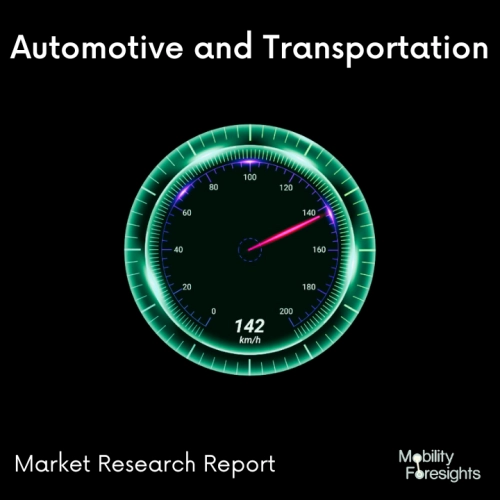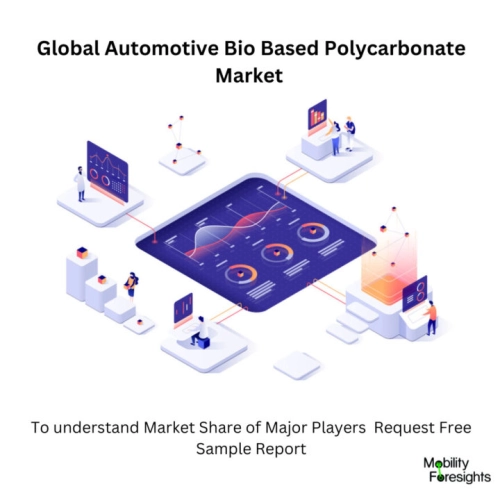
- Get in Touch with Us

Last Updated: Apr 25, 2025 | Study Period: 2024-2030
Bio-based polymers are materials for which at least a percentage of the polymer was made from raw ingredients that are renewable. Bio-based polymers, for instance, can be made from corn or sugarcane. The remaining component of the polymers may be carbon derived from fossil fuels.
Polycarbonate, similar to polypropylene, is so impact resistant that headlamp lenses and automotive bumpers are frequently made of it. This particular automotive material is extremely weather-resistant, able to withstand anything from heat and cold to rain and snow.

The Global automotive bio based polycarbonate market accounted for $XX Billion in 2023 and is anticipated to reach $XX Billion by 2030, registering a CAGR of XX% from 2024 to 2030.
New Bio-Based Engineering Plastic Durabio. DURABIO is a bio-based polycarbonate resin that is primarily made from isosorbide from plants.
In comparison to traditional polycarbonate resin (hence abbreviated PC resin) manufactured from bisphenol A (hereinafter abbreviated BPA), DURABIO has exceptional scratch resistance, great transparency, and good optical characteristics.
Its impact behaviour upon puncture is comparable to that of PC resin. Despite being a polymer made from plants, DURABIO is not biodegradable.
Its exceptional endurance allows for a wide range of applications, including the replacement of high-performance glass components in optical energy-related components, electronic equipment, vehicle housings, and interior and exterior decoration.
Due to DURABIO's exceptional durability and lack of biodegradability, it may be used in a wide range of applications.
DURABIO offers exceptional optical qualities because it uses a plant-derived raw material with a distinctively significant oxy alicyclic (non-aromatic) frame. Its optical homogeneity and transparency are superior to those of PC resins based on BPA.
Additionally, there is seldom any yellowing caused by light exposure, allowing for widespread use in applications that demand light stability. This is advantageous in transparent applications where there is less worry about colour change due to yellowing, especially for applications necessitating light-colored materials.
DURABIO also outperforms PC resin in terms of abrasion resistance while maintaining excellent surface hardness properties. Excellent surface impact resistance. DURABIO has the same ductile fracture as PC resin even in situations when acrylic resins display brittle fracture. Similar to PC resin, impact characteristics exist.
Excellent colour tone design capabilities are another advantage. The translucent material may be coloured with incredibly vibrant hues because of its exceptional transparency. It is possible to create materials with rich colours and metallic colouring.
| Sl no | Topic |
| 1 | Market Segmentation |
| 2 | Scope of the report |
| 3 | Abbreviations |
| 4 | Research Methodology |
| 5 | Executive Summary |
| 6 | Introduction |
| 7 | Insights from Industry stakeholders |
| 8 | Cost breakdown of Product by sub-components and average profit margin |
| 9 | Disruptive innovation in the Industry |
| 10 | Technology trends in the Industry |
| 11 | Consumer trends in the industry |
| 12 | Recent Production Milestones |
| 13 | Component Manufacturing in US, EU and China |
| 14 | COVID-19 impact on overall market |
| 15 | COVID-19 impact on Production of components |
| 16 | COVID-19 impact on Point of sale |
| 17 | Market Segmentation, Dynamics and Forecast by Geography, 2024-2030 |
| 18 | Market Segmentation, Dynamics and Forecast by Product Type, 2024-2030 |
| 19 | Market Segmentation, Dynamics and Forecast by Application, 2024-2030 |
| 20 | Market Segmentation, Dynamics and Forecast by End use, 2024-2030 |
| 21 | Product installation rate by OEM, 2023 |
| 22 | Incline/Decline in Average B-2-B selling price in past 5 years |
| 23 | Competition from substitute products |
| 24 | Gross margin and average profitability of suppliers |
| 25 | New product development in past 12 months |
| 26 | M&A in past 12 months |
| 27 | Growth strategy of leading players |
| 28 | Market share of vendors, 2023 |
| 29 | Company Profiles |
| 30 | Unmet needs and opportunity for new suppliers |
| 31 | Conclusion |
| 32 | Appendix |